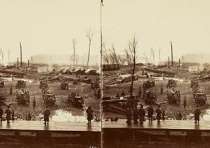
Although Forrest's activities led to the destruction of valuable Union vessels and equipment, it ultimately failed to impede Sherman's March to the Sea.
Soon after the fall of Atlanta on September 2, 1864, Confederate Lieutenant General John Bell Hood began a movement intended to cut the supply lines of Union General William T. Sherman and draw him north to Tennessee in pursuit of Hood. In mid-October, a month before Hood's invasion, Major General Nathan Bedford Forrest had moved north from Mississippi to menace Federal defenses. He reached the west bank of the Tennessee River at the Kentucky line on October 28 with some 3,500 cavalry and infantry. Capturing a gunboat and a transport as a diversion, Forrest secretly positioned his ten cannons across the river from Johnsonville, the western terminus of the Nashville and Northwestern Railroad.
On the afternoon of November 4, Forrest's gunners opened fire on three gunboats, 11 transports, and 18 barges. Union forces numbered about 2,000 men under the command of Lieutenant E. M. King and Colonel C. R. Thompson. Assuming Forrest was ready to cross the river with more than 13,000 troops, the Union commanders burned the vessels to prevent their capture. The fire spread to the docks and warehouses, and the steady blaze illuminated the river sufficiently to enable Forrest to evacuate his position during the night. Forrest arrived in Corinth on November 10 with 150 prisoners and reported to Hood in Florence, Alabama, on November 14.
The Confederates reported two dead, nine wounded, and the capture of 150 prisoners. Union losses were eight killed and wounded. Forrest estimated the value of the vessels and equipment he destroyed to be $6.7 million, although Union estimates were considerably lower. Ultimately, the Johnsonville raid failed to impede the well-supplied Sherman on his march to the sea.
The Johnsonville State Historical Area contains some of the state's best examples of Civil War fortifications, including two redoubts, rifle pits, remnants of a railroad turntable, and an early African American cemetery. It was listed on the National Register of Historic Places in 2001. The Nathan B. Forrest State Historical Area, on the west side of the river, interprets the Confederate role in the battle.
Tools
Key Facts
- Park contains excellent examples of Civil War fortifications.
- Forrest captured a gunboat as a diversion, and Union troops burned others to prevent their capture. The fire spread to docks and warehouses.




